10 Healthcare Lead Generation Strategies to Maximize Your Pipeline (Without Adding Headcount)

- Summary
- 1. Craft Ideal Customer Profiles (ICPs)
- 2. Outline the Customer Journey
- 3. Secure User/Patient/Customer Reviews
- 4. Create Content to Engage Your ICP
- 5. Leverage Social Media to Build Trust
- 6. Build a Robust SEO Program
- 7. Amplify Your Reach With Digital Advertising
- 8. Optimize Your Email Nurture Campaigns
- 9. Respond to Inquiries Quickly
- 10. Outsource the Biggest Challenges to Industry Experts
Consumers often dislike companies contacting them via cold calls, prospect lists, or misleading ads. Yet, there is a reason companies use them at times --because they work. In a time of budget cuts, it might make sense to use a clickbaity ad that converts 50% more than the precise ad at the cost of losing some clients.
With Healthcare companies, however, the same lead generation shortcuts don't work. There is too much value patients place on reputation, and rightly so, given the extensive research they do before putting their faith in health products or services, and protective laws like HIPAA make building long-term relationships vital. It's not that you should be patient with results; it's an industry requirement.
Despite these constraints, we've compiled ten ways to speed up the rate you bring leads to your healthcare company. While you or your competitors might understand the premise or strategy, having the talent and expertise to execute them as part of your marketing strategy is the difference maker.
Before we do, it's worth noting that at O8, we have many clients outsourcing their healthcare b2b lead generation to our team of marketing industry veterans and seeing massive improvements as a result. If this deep industry experience interests you, get in touch with us.
1. Craft Ideal Customer Profiles (ICPs)
An ideal customer profile (ICP) includes common characteristics of your desired customers. It includes quantitative data such as age, location, and gender and qualitative data such as their struggles, reason to believe in healthcare companies, and the tasks they must do at work.
ICPs guide your communication with potential and existing clients. For example, an online therapy directory for bankers is more likely to convert leads into customers using anecdotes, metrics, and metaphors from the financial sector than from genomics. Adapting your message to what clients know or want to know helps your ability to attract qualified leads.
How you gather your ICP information doesn't matter as long as your method gives a realistic picture of your target audience.
Conversations with the sales team of a recent client gave us a sense of our prospective clients' habits, jobs, and beliefs. We then looked into external data sources to corroborate what the sales team said:
- The U.S. Census Bureau highlighted that a significant chunk of our client's customers were middle-class health professionals, predominantly female.
- SparkToro, a consumer analytics platform, confirmed our assumptions about our customers' age brackets, media habits, and interests.
- LinkedIn revealed the content preferences of our target audience.
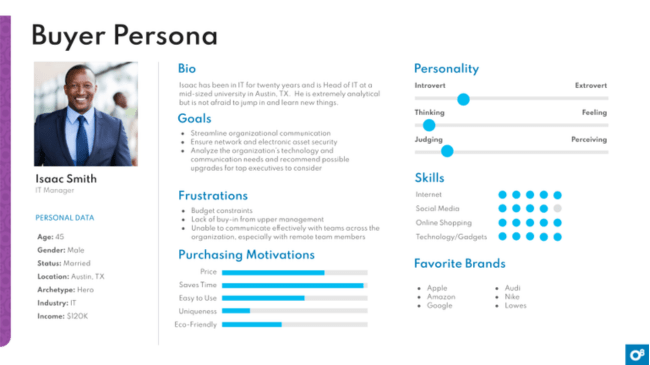
Sample O8 Buyer Persona
Merging these findings led to the comprehensive profile of the mid-30s to late 50s healthcare professionals managing compact clinics in suburban locations. With this refined understanding, we crafted marketing messages that resonated and compelled new customers to purchase. With the right ICP in hand, you can do the same.
2. Outline the Customer Journey
The term “customer journey” describes a prospect’s path from the first interaction with your brand to becoming a loyal customer and brand advocate. Breaking down people’s interactions into individual stages makes optimizing your marketing process easier.
For example, we recently worked with a healthcare company that recommends food based on your genetic information. They had significant qualified website traffic but a low conversion rate. While more prospects are often better than fewer prospects, investing in tactics that attract more prospects felt unnecessary. We already had prospects—they simply didn’t convert.
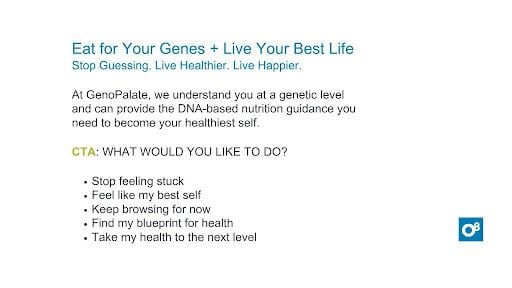
Homepage example
We created different landing pages for each customer journey stage to raise the conversion rate. Our homepage greeted visitors with questions about their health goals that decided our website's content. For example, we directed those looking to control diseases to a form and offered an e-book to those looking to lose weight. We then showed them e-books, introducing them to our client’s health services.
You can map out this journey and get similar results for your brand by asking the following questions:
- How do potential patients first encounter us?
- What are the obstacles in their buying process?
- What drives them to pick our solutions over others?
- During their research phase, what specifics are they most interested in?
- What are there pivotal moments or incentives that nudge prospects toward a purchase?
Interactive conversations with customer-facing teams, complemented by feedback from clients themselves, will aid in crafting this map.
3. Secure User/Patient/Customer Reviews
The testimonials, reviews, and comments from previous users, customers, and patients influence prospects’ buying decisions. Positive reviews instill trust, while negative ones reduce it. According to a study from the National Center for Biotechnology Information (NCBI), the number of reviews you have can sometimes matter even more than the sentiment in these reviews.
There are many healthcare and non-healthcare-specific platforms you can use to gather reviews:
- General review sites include Facebook, Google Business, and Yelp.
- Tech review sites include Capterra, G2, Software Advice, and TrustRadius.
- Review sites in the healthcare industry include Healthgrades, RateMDs, Vitals, WebMD Physician Directory, and ZocDoc.
Given the significance of sheer review volume, healthcare entities should harness multiple channels—email marketing, SMS, or even in-app prompts—to request reviews from their users or patients. A multi-channel approach increases the number of reviews you receive but also the number of platforms where high-quality leads consider you trustworthy.
4. Create Content to Engage Your ICP
Healthcare companies are part of what Google calls YMYL (Your Money or Your Life) niches. These topics could significantly impact people’s health, financial stability, safety, or well-being. Google penalizes search results from healthcare providers and products for spreading misinformation and lacking trust signals (e.g., doctors writing articles vs. teenagers) more than any other industry.
This strictness can be beneficial for healthcare companies that take content creation seriously. The barrier to entry is higher, meaning that the rewards of building trust in this space are more difficult to emulate. These rewards include familiarity, goodwill, and authority, leading to shorter sales cycles, fewer objections, and higher rankings.
Content includes any information output with the slightest intention of influencing sales. SimplePractice, an electronic health records (EHR) platform, offers a free webinar on balancing personal and professional budgets. They identified this as a topic that ICPs find helpful, making every webinar attendee a viewer and a potential lead.
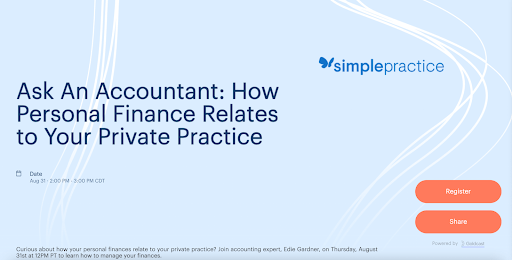
Then there’s PatientPop. They understand health practitioners struggle with visibility and competitive positioning. As a result, they added a pop-up offering a “Free Scan tool” that visitors can use to see how they stack against competitors. The tool has two purposes: to help visitors while capturing their emails.
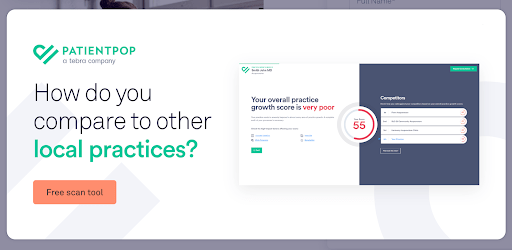
You don’t need formulas, templates, or tactics to create helpful content. Instead, look at your ICP’s pain points and ask yourself, “What information would help my ICP solve this problem?” The options will seem endless.
5. Leverage Social Media to Build Trust
As part of content marketing, social media is an indispensable channel for lead generation campaigns: You can educate prospects, build trust, and establish yourself as an authority.
Social media allows old and new patients to connect with others with similar medical conditions, share experiences, and provide emotional support. Healthcare companies can facilitate these communities, enhancing the patient experience and fostering a sense of belonging.
It’s possible to create a social media calendar solely by publishing content that helps ICPs solve their needs. But because of the YMYL nature of the field, you must adhere to specific rules when posting content on social media:
- Privacy Concerns: Respecting your clients' privacy regarding sensitive medical information is important. Before sharing any information, make sure you have proper consent.
- Regulatory Compliance: While testimonials can be beneficial, following compliance standards like HIPAA to avoid potential fines is crucial.
- Ethical Concerns: Using social media for healthcare engagement can be controversial as it may be seen as exploitative and unethical, potentially damaging your company's reputation.
But, again, your competitors also have to adhere to these regulations. The faster you respect them, the larger the gap between you and your competitors will be.
Spectrum Health, a West Michigan health system, used Hootsuite and Brandwatch to generate leads through social media. Social media specialists monitored communications and assigned them to the department most apt to answer them. This has kept the company HIPAA-compliant and capable of responding to inquiries in the mandated 24-hour window and remaining swift at dispelling health rumors.
Social media activities like Spectrum Health’s Sun Safety Twitter chat have allowed the organization to build an audience of nearly 13,000 followers. This Hootsuite case study details Spectrum Health’s strategic social media approach.
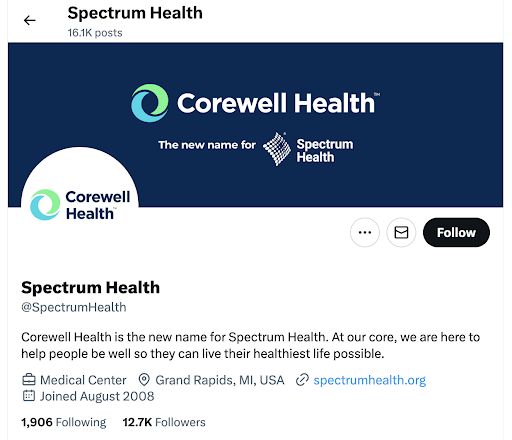
6. Build a Robust SEO Program
Search engine optimization (SEO) is a series of practices to rank your website on Google. The better your SEO, the more likely you will receive medical leads today and in the future.
Epic Systems is an electronic health records company that invests in SEO. They attract 479,000 organic visitors at each point, of which a portion are potential clients, partners, and brand advocates.

SEO is a marathon, not a sprint. Google can take months to rank your content. The algorithm is also likelier to rank the content from reputable sites higher than from new ones. Since reputation comes from the number of links from (reputable) brands you receive, it can take hundreds of days to consider the possibility of ranking for your most desired terms. But once that time passes, like Epic Systems, you can save up to $126,000 in paid advertising each month and generate pipelines worth millions of dollars almost in autopilot.
7. Amplify Your Reach With Digital Advertising
While SEO is the marathon, digital advertising is a sprint. In a few minutes, you can invest in ad networks like Meta, X, and Google to introduce your services to potential customers.
Unlike Epic Systems, UL Solutions has no SEO-optimized website that brings them a steady flow of leads. The applied safety science advisory and development program overcomes this challenge by advertising on Google. According to Ahrefs data, UL Solutions:
- Strategically biding on a wide array of terms—202 different keywords. This approach casts a wide net and acknowledges the myriad ways potential clients might search for the organization’s services.
- Targets variations of the same keyword. UL Solutions bids on the terms “EHR company,” “EHR platform,” and “electronic health records systems.” By bidding on these terms, UL Solutions captures prospects using different words in search of the same solution.
UL Solutions and other companies should not pursue digital advertising instead of SEO. Instead, digital advertising allows companies like UL Solutions to gain on competitors like Epic Systems while investing the time needed to optimize for organic search.
Define your desired outcome before investing in a paid advertising campaign. Are you looking to increase patient appointments, introduce a new service, or raise awareness about a specific medical condition? By establishing specific and measurable objectives, you can develop a targeted campaign strategy that will effectively guide your efforts.
The information in your ICP will guide who to target, the ad network to do it, and the words you will use. Not having this information indicates that you probably need to return to step one.
Given the sensitive nature of healthcare advertising, it's crucial to comply with healthcare regulations, such as HIPAA (in the United States). Ensure that your ad content and targeting methods adhere to these regulations to protect patient privacy and avoid legal issues.
8. Optimize Your Email Nurture Campaigns
Email nurturing is when businesses use emails to build relationships with potential customers. These emails are typically part of a campaign to encourage a specific response after providing information.
VirtaMed used the HubSpot CRM to send lead nurturing emails to prospects. They used HubSpot’s consumer intelligence to personalize every email to prospects’ interests. After the campaign, VirtaMed’s email interactions, website traffic (39%), and (18%) organic traffic went up.
For your first email nurture campaign, keep it simple by only sending four emails:
- Welcome Email: Extend a warm welcome to the new subscriber, expressing gratitude for joining your list. Provide a brief introduction to your healthcare organization, maintaining a concise and friendly tone.
- Provide Value: In subsequent emails, focus on delivering substantial value to the subscriber. Share informative content, healthcare insights, or valuable resources that align with your expertise. For instance, if your practice specializes in dental care, consider offering tips for maintaining optimal oral health.
- Introduce Your Services: Gradually introduce your healthcare services or specialized offerings in the later emails of the series. Emphasize how these services can positively impact the subscriber's well-being and cater to their healthcare requirements.
- Include Clear Calls to Action (CTAs): Ensure each email features a clearly defined Call to Action (CTA) that directs the subscriber toward the next steps. These actions include scheduling an appointment, downloading a healthcare guide, or subscribing to a newsletter.
As for what’s valuable, what you should highlight, and what the CTAs should be, look at the information from your ideal customer profile.
9. Respond to Inquiries Quickly
In the age of digital immediacy, the speed at which companies respond to leads can make or break a sale. Rapid responses increase the chances of making contact, qualifying, and converting the lead.
A 2007 MIT/InsideSales.com study sought to answer the question: When should you call new leads to maximize your contact and qualification numbers? The study examined six companies, 15,000-plus leads, and 100,000-plus call attempts. It found that the odds of contacting a lead decreased tenfold within the first hour. If a lead is contacted within 5 minutes versus 30 minutes, the chances of making contact plummet 100 times, and the odds of qualification drop 21 times.
A study shared in a 2011 issue of Harvard Business Review found that companies that reached out within an hour of receiving a lead were almost seven times more likely to qualify for the lead. They were 60 times more likely than companies that waited 24 hours or more.
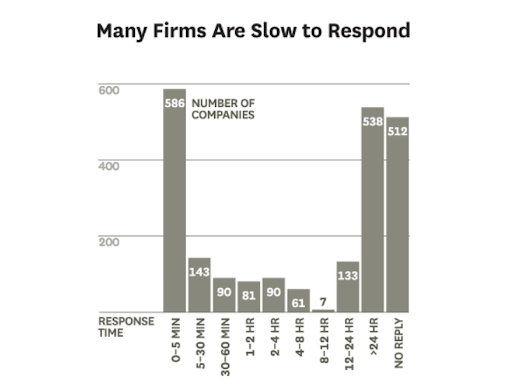
If you respond within the first five minutes, you are twice as likely to convert leads than a competitor who doesn’t. Image source.
No similar studies have been conducted post-COVID-19, but response times are likely more important now than ever as attention spans continue to shrink. It’s not enough to generate online leads; companies must act swiftly. With the proliferation of online platforms, consumers have many options at their fingertips. Delayed responses allow potential customers to explore alternatives, reducing the chances of conversion.
10. Outsource the Biggest Challenges to Industry Experts
If you have the budget to outsource your lead generation or work with a partner willing to guarantee results, do it. Mednition’s story shows why. Like many health tech companies, Mednition struggled with a small marketing team and the immense weight of various marketing responsibilities. Despite capability and an understanding of the broader marketing landscape, the CMO faced capacity issues, lacking a team to execute his plans.
Enter O8 with its fractional marketing team services. Mednition leveraged O8’s vast industry experience and tapped into a team that could effectively handle various marketing tasks—including SEO, content strategy, user experience, and analytics setup. A single solution—hiring us—brought peace of mind to the CMO and covered their marketing needs.
To outsource your healthcare lead gen as Mednition did, contact us to learn about our healthcare lead generation services.
